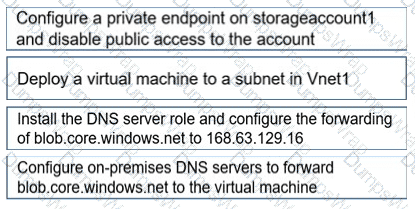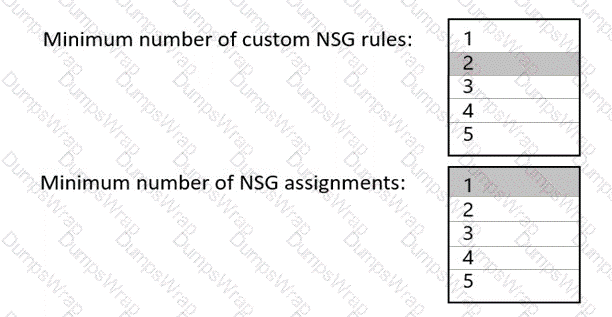Designing and Implementing Microsoft Azure Networking Solutions Questions and Answers
You need to configure a security rule for APPGW1-NSG1. The solution must support the planned changes. Which service tag should you use?
You need to deploy Azure Virtual Network Manager. The solution must support the planned changes and meet the connectivity requirements.
Which four actions should you perform in sequence? To answer, move the appropriate actions from the list of actions to the answer area and arrange them in the correct order.
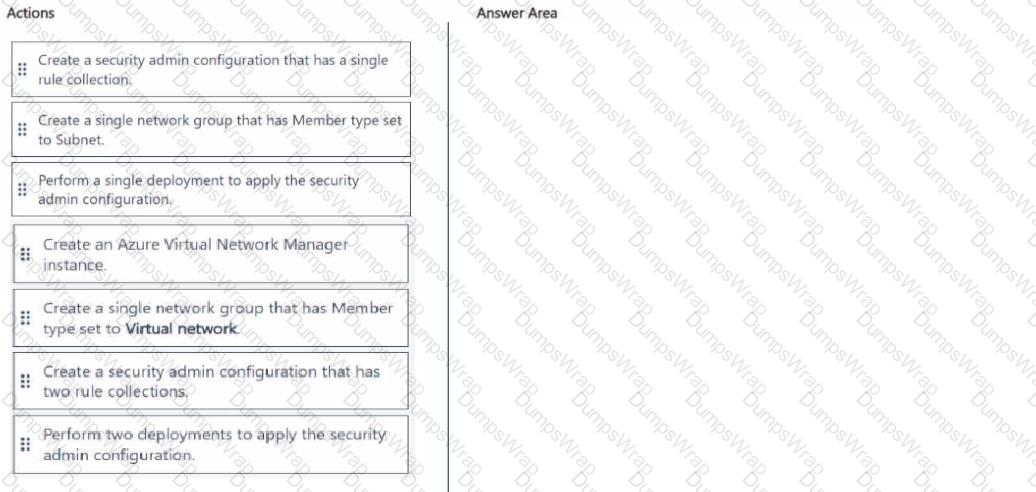
You need to configure FD1 to provide user access to app2.proseware.com. The solution must meet the security requirements and the general requirements.
What should you do first?
You need to configure a custom rule for APPGWI-WAFPolicy to allow only connections that originate from FD1. The solution must support the planned changes.
Which Match type and Match variable should you select?
You need to plan the deployment of LBGW1. The solution must support the planned changes.
What should you include in the solution? To answer, select the appropriate options in the answer area.
NOTE: Each correct selection is worth one point.

You ate configuring the DNS forwarding luleset for DNSR1
You need to configure the destination IP address for azure.proseware.com and for corp.proseware.com. The solution must meet the general requirements.
Which IP addiesses should you configure for each namespace? To answer, select the appropriate options in the answer area.
NOTE: Each correct selection is worth one point.

You need to configure connectivity between NYCNet and SFONet. The solution must meet the connectivity requirements. What should you do? To answer, select the appropriate options in the answer area. NOTE: Each correct selection is worth one point.

You need to identify which IP address space to allocate for the planned deployment of PRDNS1 to HubVNet and SpokeVNet. The solution must meet the general requirements
What should you identify for each virtual network? To answer, select the appropriate options in the answer area. NOTE: Each correct selection is worth one point.
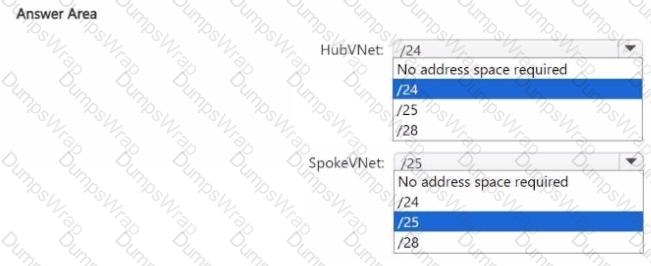
You need to configure APPGW1 to support end-to-end encryption. The solution must meet the security requirements. What should you do?
You need to manage connectivity from NYCNet to the Azure services that use private endpoints. The solution must meet the security requirements. What should you do first?
You need to configure the P2S VPN to meet the connectivity requirements.
What should you do? To answer, select the appropriate options in the answer area.
NOTE: Each correct selection is worth one point.

You are implementing the virtual network requirements for VM Analyze.
What should you include in a custom route that is linked to Subnet2? To answer, select the appropriate options in the answer area.
NOTE: Each correct selection is worth one point.
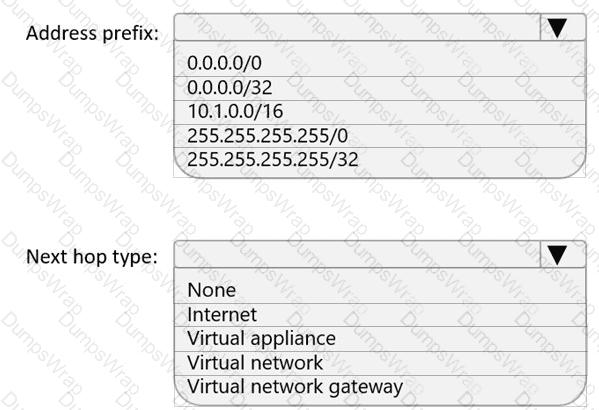
For each of the following statements, select Yes if the statement is true. Otherwise, select No.
NOTE: Each correct selection is worth one point.

You need to configure GW1 to meet the network security requirements for the P2S VPN users.
Which Tunnel type should you select in the Point-to-site configuration settings of GW1?
You create NSG10 and NSG11 to meet the network security requirements.
For each of the following statements, select Yes it the statement is true. Otherwise, select No.
NOTE: Each correct selection is worth one point.

In which NSGs can you use ASG1 and to which virtual machine network interfaces can you associate ASG1? To answer, select the appropriate options in the answer area.
NOTE: Each correct selection is worth one point.

You need to meet the network security requirements for the NSG flow logs.
Which type of resource do you need, and how many instances should you create? To answer, select the appropriate options in the answer area.
NOTE: Each correct selection is worth one point.

What should you implement to meet the virtual network requirements for the virtual machines that connect to Vnet4 and Vnet5?
You have an Azure subscription that contains the virtual networks shown in the following table.

The subscription contains the virtual machines shown in the following table.

You create a load balancer named LB1 that has the following configurations:
• SKU: Basic
• Type: Internal
• Subnet: Subnetl2
• Virtual network VNet1
For each of the following statements, select Yes if the statement is true. Otherwise, select No. NOTE: Each correct selection is worth one point.

You have an on-premises DNS server named Server1 that hosts a primary DNS zone named fabrikam.com.
You have an Azure subscription that contains the resources shown in the following table.

Users on the on-premises network access resources on all the virtual networks by using a Site-to-Site (S2S) VPN. You need to deploy an Azure DNS Private Resolver solution that meets the following requirements:
• Resources connected to the virtual networks must be able to resolve DNS names for fabrikam.com.
• Server1 must be able to resolve the DNS names of the resources in contoso.com.
• The solution must minimize costs and administrative effort.
What is the minimum number of resolvers you should deploy?
You configure a route table named RT1 that has the routes shown in the following table.

You have an Azure virtual network named Vnet1 that has the subnets shown in the following table.

You have the resources shown in the following table.

Vnet1 connects to an ExpressRoute circuit. The on-premises router advertises the following routes:
* 0.0.0.0/0
* 10.0.0.0/16
For each of the following statements, select Yes if the statement is true. Otherwise, select No. NOTE: Each correct selection is worth one point.

You have an Azure Front Door instance that has a single frontend named Frontend1 and an Azure Web Application Firewall (WAF) policy named Policy1. Policy1 redirects requests that have a header containing "string1" to Policy1 is associated to Frontend1.
You need to configure additional redirection settings. Requests to Frontend1 that have a header containing "string2" must be redirected to
Which three actions should you perform? Each correct answer presents part of the solution.
NOTE: Each correct selection is worth one point.
You plan to publish a website that will use an FQDN of The website will be hosted by using the Azure App Service apps shown in the following table.

You plan to use Azure Traffic Manager to manage the routing of traffic for between AS1 and AS2.
You need to ensure that Traffic Manager routes traffic for
Which DNS record should you create?
You have a network security group named NSG1.
You need to enable network security group (NSG) flow logs for NSG1. The solution must support retention policies.
What should you create first?
You have an Azure subscription. The subscription contains virtual machines that host websites as shown in the following table.

You have the Azure Traffic Manager profiles shown in the following table.

You have the endpoints shown in the following table.
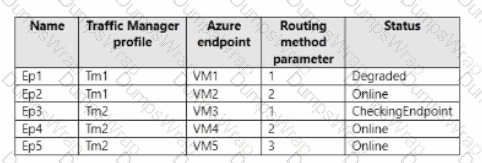
For each of the following statements, select Yes if the statement is true. Otherwise select No.
NOTE: Each connect selection is worth one point.

You have an Azure subscription that contains the virtual networks shown in the following table.

You plan to deploy an Azure firewall named AF1 to RG1 in the West US Azure region.
To which virtual networks can you deploy AF1?
Note: This question is part of a series of questions that present the same scenario. Each question in the series contains a unique solution that might meet the stated goals. Some question sets might have more than one correct solution, while others might not have a correct solution.
After you answer a question in this section, you will NOT be able to return to it. As a result, these questions will not appear in the review screen.
You have an Azure application gateway that has Azure Web Application Firewall (WAF) enabled.
You configure the application gateway to direct traffic to the URL of the application gateway.
You attempt to access the URL and receive an HTTP 403 error. You view the diagnostics log and discover the following error.
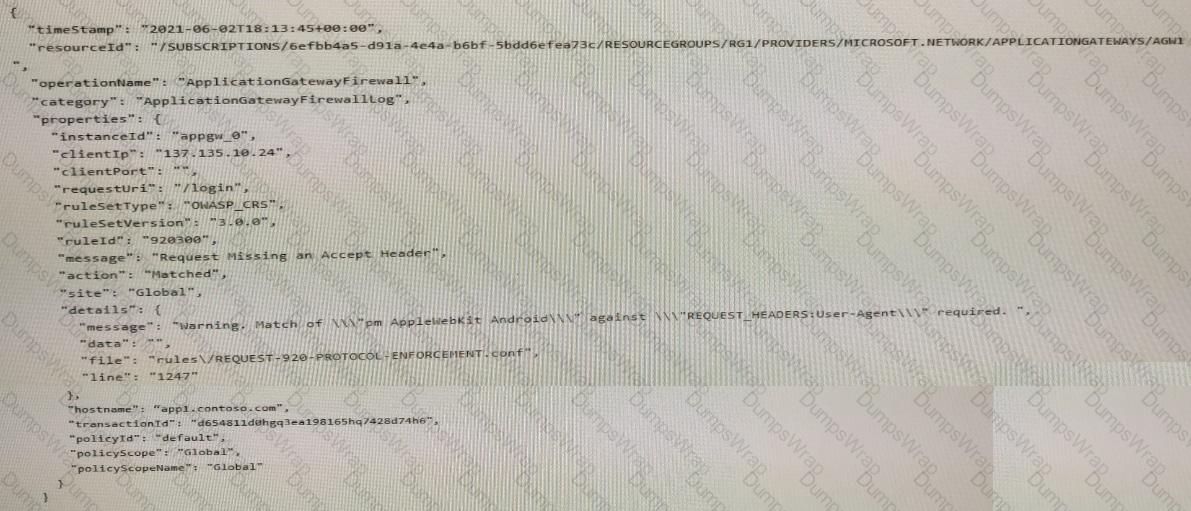
You need to ensure that the URL is accessible through the application gateway.
Solution: You disable the WAF rule that has a ruleld of 920300.
Does this meet the goal?
You have three on-premises sites. Each site has a third-party VPN device.
You have an Azure virtual WAN named VWAN1 that has a hub named Hub1. Hub1 connects two of the three on-premises sites by using a Site-to-Site VPN connection.
You need to connect the third site to the other two sites by using Hub1.
Which four actions should you perform in sequence? To answer, move the appropriate actions from the list of actions to the answer area and arrange them in the correct order.

Note: This question is part of a series of questions that present the same scenario. Each question in the series contains a unique solution that might meet the stated goals. Some question sets might have more than one correct solution, while others might not have a correct solution.
After you answer a question in this section, you will NOT be able to return to it. As a result, these questions will not appear in the review screen.
You have two Azure virtual networks named Vnet1 and Vnet2.
You have a Windows 10 device named Client1 that connects to Vnet1 by using a Point-to-Site (P2S) IKEv2 VPN.
You implement virtual network peering between Vnet1 and Vnet2. Vnet1 allows gateway transit. Vnet2 can use the remote gateway.
You discover that Client1 cannot communicate with Vnet2.
You need to ensure that Client1 can communicate with Vnet2.
Solution: You enable BGP on the gateway of Vnet1.
Does this meet the goal?
You are planning the IP addressing for the subnets in Azure virtual networks. Which type of resource requires IP addresses in the subnets?
You need to connect an on-premises network and an Azure environment. The solution must use ExpressRoute and support failing over to a Site-to-Site VPN connection if there is an ExpressRoute failure.
What should you configure? To answer, select the appropriate options in the answer area.
NOTE: Each correct selection is worth one point.

You have an Azure virtual network named Vnet1 that connects to an on-premises network.
You have an Azure Storage account named storageaccount1 that contains blob storage.
You need to configure a private endpoint for the blob storage. The solution must meet the following requirements:
Ensure that all on-premises users can access storageaccount1 through the private endpoint.
Prevent access to storageaccount1 from being interrupted.
Which four actions should you perform in sequence? To answer, move the appropriate actions from the list of actions to the answer area and arrange them in the correct order.

You have an Azure virtual network named VNet1 that contains the subnets shown in the following table.

You need to deploy an Azure application gateway named AppGW1 to VNetl To where can you deploy AppGW1?
You plan to deploy Azure Virtual WAN.
You need to deploy a virtual WAN hub that meets the following requirements:
Supports 10 sites that will connect to the virtual WAN hub by using a Site-to-Site VPN connection
Supports 8 Gbps of ExpressRoute traffic
Minimizes costs
What should you configure? To answer, select the appropriate options in the answer area.
NOTE: Each correct selection is worth one point.
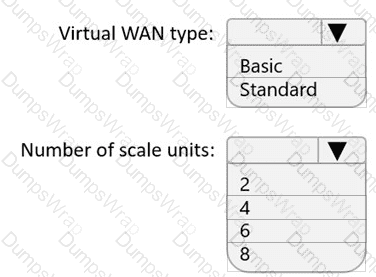
You have the Azure load balancer shown in the Load Balancer exhibit.

LB2 has the backend pools shown in the Backend Pools exhibit.
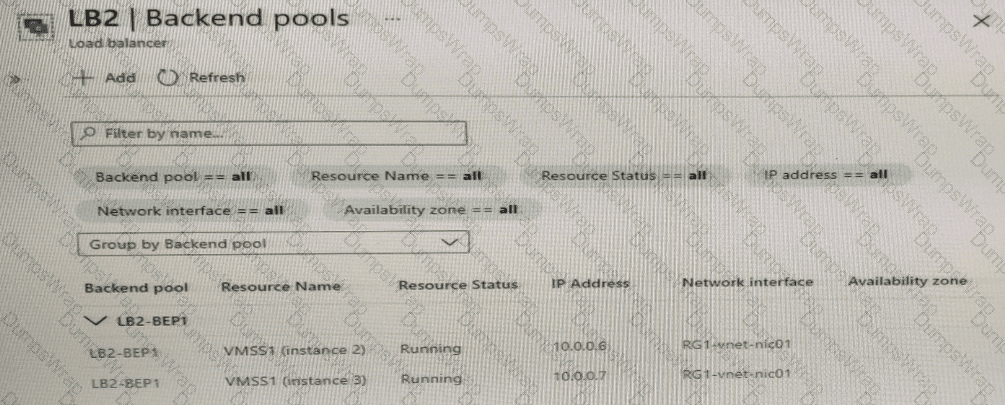
You need to ensure that LB2 distributes traffic to all the members of VMSS1.
Which two actions should you perform? Each correct answer presents part of the solution.
NOTE: Each correct selection is worth one point.
You have an Azure Private Link service named PL1 that uses an Azure load balancer named LB1. You need to ensure that PL1 can support a higher volume of outbound traffic. What should you do?
Task 5
You need to ensure that requests for wwwjelecloud.com from any of your Azure virtual networks resolve to frontdoor1.azurefd.net.
Task 10
You need to configure VNET1 to log all events and metrics. The solution must ensure that you can query the events and metrics directly from the Azure portal by using KQL.
Task 5
You need to archive all the metrics of VNET1 to an existing storage account.
Task 6
You have two servers that are each hosted by a separate service provider in New York and Germany. The server hosted in New York is accessible by using a host name of ny.contoso.com. The server hosted in Germany is accessible by using a host name of de.contoso.com.
You need to provide a single host name to access both servers. The solution must ensure that traffic originating from Germany is routed to de contoso.com. All other traffic must be routed to ny.contoso.com.
Task 9
You plan to use VNET4 for an Azure API Management implementation.
You need to configure a policy that can be used by an Azure application gateway to protect against known web attack vectors. The policy must only allow requests that originate from IP addresses in Canada. You do NOT need to create the application gateway to complete this task.
Task 1
You need to ensure that virtual machines on VNET1 and VNET2 are included automatically in a DNS zone named contoso.azure. The solution must ensure that the virtual machines on VNET1 and VNET2 can resolve the names of the virtual machines on either virtual network.
Task 3
You plan to implement an Azure application gateway in the East US Azure region. The application gateway will have Web Application Firewall (WAF) enabled.
You need to create a policy that can be linked to the planned application gateway. The policy must block connections from IP addresses in the 131.107.150.0/24 range. You do NOT need to provision the application gateway to complete this task.
Task 9
You need to ensure that subnet4-3 can accommodate 507 hosts.
Task 4
You need to ensure that connections to the storage34280945 storage account can be made by using an IP address in the 10.1.1.0/24 range and the name storage34280945.pnvatelinlcblob.core.windows.net.
Task 8
You need to ensure that the storage34280945 storage account will only accept connections from hosts on VNET1
Task 4
You need to ensure that the owner of VNET3 receives an alert if an administrative operation is performed on the virtual network.
Task 2
You need to create an Azure Firewall instance named FW1 that meets the following requirements:
• Has an IP address from the address range of 10.1.255.0/24
• Uses a new Premium firewall policy named FW-pohcy1
• Routes traffic directly to the internet
Task 2
You need to ensure that you can deploy Azure virtual machines to the France Central Azure region. The solution must ensure that virtual machines in the France Central region are in a network segment that has an IP address range of 10.5.1.0/24.
Task 3
You need to ensure that hosts on VNET1 and VNET2 can communicate. The solution must minimize latency between the virtual networks.
Task 1
You plan to deploy a firewall to subnetl-2. The firewall will have an IP address of 10.1.2.4.
You need to ensure that traffic from subnetl-1 to the IP address range of 192.168.10.0/24 is routed through the firewall that will be deployed to subnetl-2. The solution must be achieved without using dynamic routing protocols.
Task 11
You need to ensure that only hosts on VNET1 can access the slcnage42150372 storage account. The solution must ensure that access occurs over the Azure backbone network.
Task 11
You are preparing to connect your on-premises network to VNET4 by using a Site-to-Site VPN. The on-premises endpoint of the VPN will be created on a firewall named Firewall 1.
The on-premises network has the following configurations:
• Internal address range: 10.10.0.0/16.
• Firewall 1 internal IP address: 10.10.1.1.
• Firewall1 public IP address: 131.107.50.60.
BGP is NOT used.
You need to create the object that will provide the IP addressing configuration of the on-premises network to the Site-to-Site VPN. You do NOT need to create a virtual network gateway to complete this task.
Task 6
You need to ensure that all hosts deployed to subnet3-2 connect to the internet by using the same static public IP address. The solution must minimize administrative effort when adding hosts to the subnet.
You need to provide connectivity to storage1. The solution must meet the PaaS networking requirements and the business requirements.
What should you include in the solution?
You need to restrict traffic from VMScaleSet1 to VMScaleSet2. The solution must meet the virtual networking requirements.
What is the minimum number of custom NSG rules and NSG assignments required? To answer, select the appropriate options in the answer area.
NOTE: Each correct selection is worth one point.
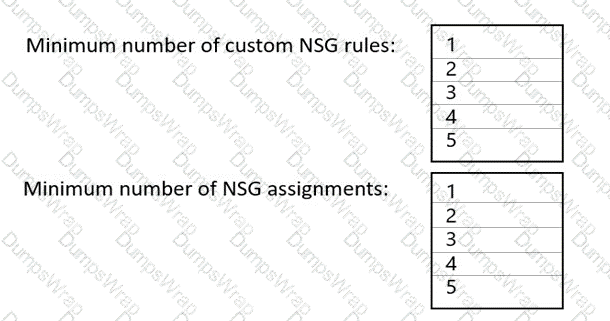
You need to recommend a configuration for the ExpressRoute connection from the Boston datacenter. The solution must meet the hybrid networking requirements and business requirements.
What should you recommend? To answer, select the appropriate options in the answer area.
NOTE: Each correct selection is worth one point.

You need to prepare Vnet1 for the deployment of an ExpressRoute gateway. The solution must meet the hybrid connectivity requirements and the business requirements.
Which three actions should you perform in sequence for Vnet1? To answer, move the appropriate actions from the list of actions to the answer area and arrange them in the correct order.

You need to implement outbound connectivity for VMScaleSet1. The solution must meet the virtual networking requirements and the business requirements.
Which three actions should you perform in sequence? To answer, move the appropriate actions from the list of actions to the answer area and arrange them in the correct order.
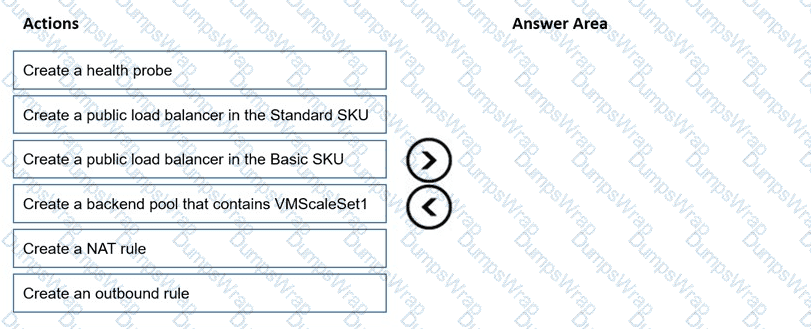
You need to connect Vnet2 and Vnet3. The solution must meet the virtual networking requirements and the business requirements.
Which two actions should you include in the solution? Each correct answer presents part of the solution.
NOTE: Each correct selection is worth one point.
You need to provide access to storage2. The solution must meet the PaaS networking requirements and the business requirements.
Which connectivity method should you use?
You need to implement a P2S VPN for the users in the branch office. The solution must meet the hybrid networking requirements.
What should you do? To answer, select the appropriate options in the answer area.
NOTE: Each correct selection is worth one point.

You need to implement name resolution for the cloud.liwareinc.com. The solution must meet the networking requirements.
What should you do? To answer, select the appropriate options in the answer area.
NOTE: Each correct selection is worth one point.

You need to configure the default route in Vnet2 and Vnet3. The solution must meet the virtual networking requirements.
What should you use to configure the default route?
ESTION NO: 1
You need to configure the default route on Vnet2 and Vnet3. The solution must meet the virtual networking requirements.
What should you use to configure the default route?


















